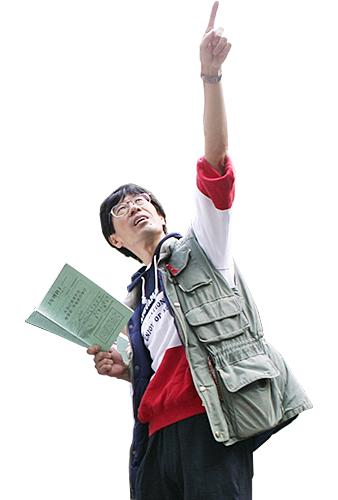理科教諭なべやんの「学内探訪」 Nabeyan's Column
2016年5月より、本校理科教諭の田邉利幸が綴った「学内探訪」コラムを連載していきます。
キャンパス内の名所や豊かな自然環境をご紹介していきます。
連載!理科教諭なべやんの「学内探訪」
<掲載に際して>
「学校」という空間は、人間が生活する環境の中でも”特異”な空間です。本校の場合主に近畿圏各地の居住地域から、900名近い人々がこの岩倉の地に通い、集い、学び、お互いを高め成長する場となっています。
そして午前8時から午後5時までの校内は、未来の無限の可能性を秘めた若者の活気が満ち満ちています。ある場面では授業としての「教科の学び」が、また「かけがえのない友人との語り合いや交流」が、そして放課後は「個性的で多様な先輩や後輩との学び合い」と、学び通しの9時間があっという間に過ぎていきます。
これらのさまざまな経験は、今後の豊かな人生を築き上げていく上で何よりも大切な宝物です。
そんな豊かな3年間を「学校環境」の視点から振り返ってみた時、この地には四季折々に変化する比叡山や北山、西に流れる岩倉川の自然の景観や、季節の移ろいを感じて多様に変遷する豊かな動植物が生息しています。そして同時に、香山建築研究所の設計による建造物、空間構成、そこに組み込まれた”芸術作品”にも注目したいと感じました。子どもたちが快適に生活できることを何よりも大切にし、校地の空間や構造物のデザイン、校舎間や空き地への動きを科学する「動線の科学」、教科教室内の機能性や教科MSの空間構成など、本校に関わるデザイン的要素のすべてが「芸術作品」であり、また、「建築工学の最先端の現場」でもあるように思うのです。いわば子どもたちは、宇宙・自然・芸術・環境・人間・工学の多様な視点から創造された作品群の中で学校生活を送っていると言っても過言ではないと思います。
ある時、何気なく校内を歩いていると、自然物や構造物の方から次から次にメッセ-ジが伝わってきました。今回そのメッセ-ジに促されて、「学内探訪」(適宜「学外探訪」も)と題する連載を記してみます。雑駁な文章で不足を感じる点は多々ありますが、ご一読いただきご批判、ご鞭撻いただければ幸いです。尚、英文Summaryは本校英語科のDavid Foremanが担当しています。
田邉利幸
第103回 植物に寄り添う
~立志館東ガ-デン~

4月中旬のある日、立志館東側に植栽を中心とした素敵なガ-デンがお目見えしました。
花崗岩風の一風変わった形状のブロックに囲まれた種々の植物は14種類。中央には、このガ-デンに象徴的な鉢とおしゃれな扉が位置し、このガ-デンの空間構成の中心的なシンボルとなっています。
そして何より、立志館のレンガ壁を「キャンバス」の下地のように利用し、このガ-デン全体が壁面に添えられた芸術作品となっています。その結果、このエリアには独特の芸術的空気感が漂っています。みなさんも、このガ-デンとひとつひとつの植物、そしてこの空間を末永く愛していただけたら、これ以上の喜びはありません。尚、このガ-デンは「2021年度卒業記念品」として製作されたものです。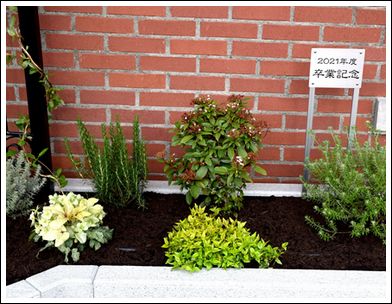
最後に、このガ-デンを製作されたランドスケ-プワタナベさまから、このガ-デンへのメッセ-ジを記して戴きましたので、以下に紹介させていただきます。
人は森を切り開き発展してきたが、他の生き物に寄り添ってもらわなければ生きてゆくことが出来ません。
この時代に地球からのメッセ-ジを受け、人類の過激な行動や急速な発展も少しブレ-キを掛ける必要があるように思います。
人々が他の生き物に向き合い慈しんでくださることを願ってこれを造形します。
渡邊株式会社 ランドスケ-プワタナベ
代表取締役 渡邊良宣
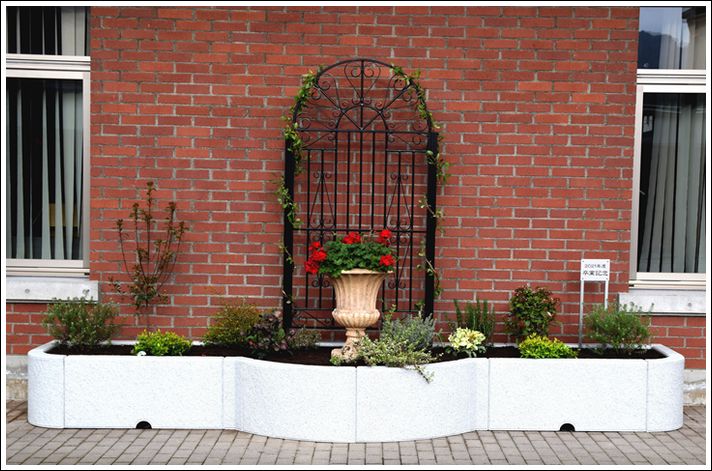
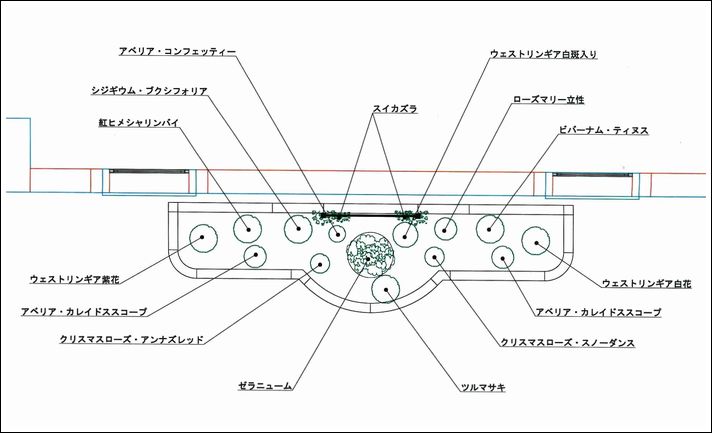
Feeling Closer Through the Garden
In the middle of April, we were able to see a new landscaped garden on the eastern side of the Risshikan Building.
There are 14 different plants and flowers within a uniquely shaped granite style planter. In the center of the garden is a symbolic pot and a beautiful gate, both of which represent the special structure of the garden.
Most of all, the garden seems to form a work of art painted on a canvas that is the brick wall of the Risshikan Building. Because of this, the area feels like a special artistic space. We hope that everyone can enjoy the different plants in this garden and its surroundings for a long time. This garden was a gift from our graduate students in 2021.
We received a message from Mr. Watanabe, the designer of the garden.
“People cut down forests, but we need to feel closer to living things if we want to live. In these times, I think we should listen to the messages from our Earth and put a brake on our extreme actions and our rapid growth. I designed this with the hope that people will see and feel compassion for living things.”
《Words》 ~を表現する、~を象徴する represent、レンガ壁 brick wall、卒業生 graduate students、過激な行動 extreme actions、急速な発展 rapid growth
第102回 季節の色を求めて
~花鳥草蝶の黄色~

3月末は、暖かい日が続いたり、また寒い日が続いたりを繰り返す「三寒四温」の日々でした。そんな時期、学内や周囲の自然の中の色の中で「黄色」という色に注目した自然のようすを紹介しましょう。
野山では、雪の中から現れる福寿草も黄色の花です。
不思議と「黄色」という色は初春からの目立つ色彩で、春の訪れを真っ先に告げる色のように思います。

白梅のつぼみやおしべ、菜の花のなかま、レンギョウ、サンシュユの他、タンポポやウマノアシガタなど黄色が目立つ植物が多く観られます。
鳥類ではマヒワ、キセキレイなどが岩倉川、宝ヶ池で遊び、少し暖かい日にはキチョウがひらひらと舞っていました。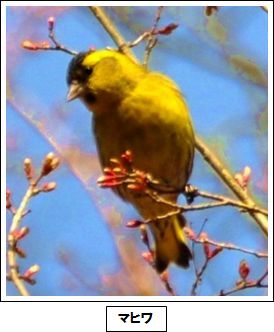
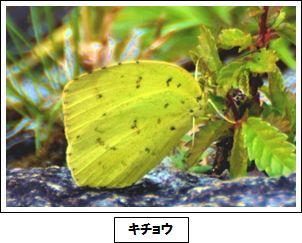
みなさんも身近な自然の特定の「色」に着目して観察すると、いつもとは違った自然の見方ができると思います。天気がいい時に挑戦してみてください。
The Color of the Season
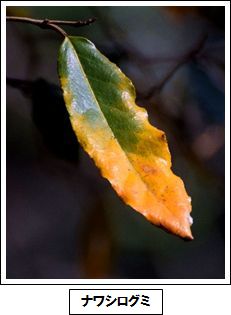
At the end of March the weather was very changeable. It was hot and then cold, so it was the common cycle of “3 cold days followed by 4 warm ones”. In this season, we can often see the color “yellow” in the nature around the school. This is the color of the Amur Adonis (Fork-Stem Adonis) that is found in the hills. It is interesting that yellow is a color that stands out at the start of spring, and lets us know the seasons are changing.
We can also see that yellow stands out in the flowers and parts of the White Plums, the Rape Blossoms, the Golden Bells, the Cornus, the Dandelions, and the Japanese Buttercups.
As for birds, around the Iwakura River and Takaragaike we can see yellow in Siskins and Grey wagtails, as well as the Common Grass Yellow butterflies on warm spring days.
If you look for a certain color in the nature around you, you will probably be able to see things in a different way. Please try it on a sunny day.
《Words》 福寿草 Amur Adonis、三寒四温 (a cycle of) three cold days followed by four warm ones、天気のいい日 a sunny day

第101回 寅年の鳥
~鵺(ぬえ)鳥物語~

今年は「寅年」。実は、学内では密かに昨年末から今年にかけて「トラ」についての話題で盛り上がっていました。「トラ」と言っても哺乳類のトラではなく、野鳥の「トラツグミ」です。
最初の写真は、宝ヶ池の土手で採餌しているトラツグミです。周囲に溶け込んでいますが中央にいます。
実は昨年末、中央門衛所の門衛さんが、地下鉄2番出口付近の地上で弱っていた鳥を、通行人の方が大事そうに歩道横に置かれる様子を目撃され、様子を見に行かれたところ、トラツグミだったとのことでした。
トラツグミは、ガラス壁にぶつかった衝撃で軽い脳震盪を起こしていたようで、その日から1日間は暗めの部屋で鳥かごで保護していました。翌日にはとても元気になり、そこでかごの扉を開けたところ、元気に宝ヶ池方面に羽ばたいて行きました。
今回、宝ヶ池で確認したトラツグミが、この年末の鳥と同じかどうかは不明ですが、宝ヶ池の山々で元気に過ごしてくれていたらこれ以上の嬉しいことはありません。
ところでこの鳥は鳴き声が独特で、昔から「鵺(ぬえ)」という妖怪に間違えられたこともありました。『平家物語』には、顔は猿、胴体は狸、手足は虎、尾は蛇という伝説が記され、弓の名手源頼政が鵺を退治したという伝説もあります。
近くの暗い森で「ヒュウ、フュウ」という声が響いていたら、それは鵺鳥「トラツグミ」の声です。

Birds in the Year of the Tiger
This is the Year of the Tiger (or “Tora” in Japanese). Actually, since last year, I have been interested in the topic of a “Tora”. Not the mammal “Tora” (Tiger), but a bird “Tora-tuugumi” or “Scaly Thrush”.
In the first photo, you can see a Scaly Thrush that I recently saw searching for food at Takaragaike. It seems to blend in well with the surroundings.
At the end of last year, one of the staff from the guard box at the entrance to the school contacted me about a bird that had been found in a weak condition outside the subway station. I went to check on it, and found that it was a Scaly Thrush. It seemed that it had crashed into a glass panel and was concussed, so I decided to keep it in a dark room at school to recover. The next day, the bird was healthy again, and it soon flew from the window towards Takaragaike.
I’m not sure if the Scaly Thrush I saw at Takaragaike is the same as the one that I helped at the end of last year, but I hope that it is doing ok now. By the way, this bird has a very unique way of singing that is like a Japanese mythical creature called a “Nue”, so has been mistaken for it in the past. In an ancient tale, the Nue is said to have a monkey’s head, a tanuki’s body, a monkey’s legs, and a snake’s tail. In the tale, a famous archer Minamoto No Yorimasa drove the Nue away.
If you hear a bird singing “Hyuu Fyuu” in the dark forest, it would be a Scaly Thrush.
《Words》 トラツグミ Scaly Thrush、ガラス壁 glass panel、暗い森で in the dark forest
第100回 1700年前の暮らしを想う…。
~岩倉忠在地遺跡を訪ねて~

2022年を生きる私たちは何かといそがしく、1700年ほど前の人々の暮らしなど想像することなど滅多にありません。
でも、歴史的事実としての「証拠」を目にすると当時の人々の生活を想像することは可能です。
現代とは食生活、時の流れ、日々見る風景、季節感、ものごとに対する価値観など、全く異なる「岩倉先住民」の生活の様子を思い浮かべ想像してみることは、思考の柔軟性にも効果的です。
みなさんは、当時の自然環境や気候に影響されながらも、天体の歩みにフィットした”スロ-ライフ”生活に憧れたりしませんか。
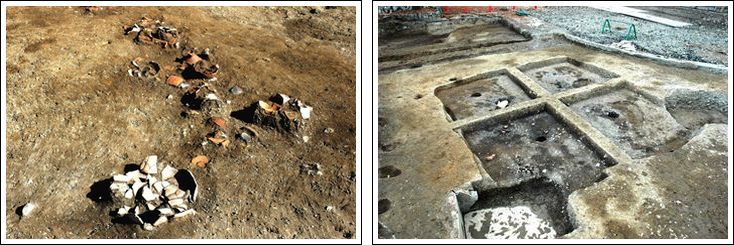
さて、最初の写真は、立志館北西角から同志社小学校までの場所で発掘された「竪穴式住居跡」です。古墳時代初期の3世紀前半の住居跡と考えられています。ここで生活していた人が東方を眺めると比叡山が正面です。この山をどのような思いで眺めていたのでしょうか。
2段目右の住居跡は、カフェテリア厨房の位置に相当します。これは4世紀の竪穴住居と言われています。土器が曲線に並んでいる場所もありました。
この曲線にはいったいどのような意味があるのか想像力が高まります(現カフェテリア北西角)。
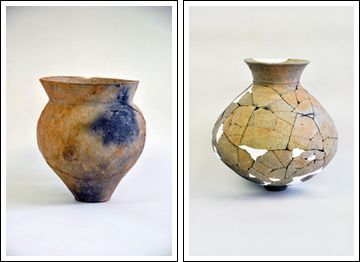
次に、南方へ視点を向けてみましょう。当時は岩倉川も大雨の度に流路があばれ、住居近くで洪水が起きたことでしょう。そして現在の南グラウンドあたりには広い湿地帯ができて、いろいろな水鳥が遊び、湿地帯特有の動植物が生息していたと推定できます。
みなさん、3世紀の岩倉の原風景が眼前に広がりましたか?
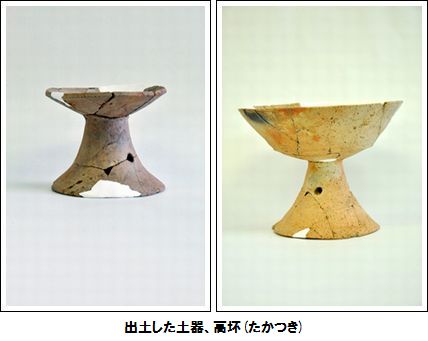
写真は、若林邦彦氏(同志社大学歴史資料館)より提供していただきました。感謝申し上げます。
Thinking About Living 1,700 Years Ago
In 2022, our lives are so busy that we rarely get time to think about how people lived 1,700 years ago. But when we are able to see the historical “evidence”, we are able to imagine their lifestyles.
Nowadays, with our eating habits, the way we see our everyday lives or sense the seasons, and the way we value things make it difficult to imagine without having a flexible way of thinking how the original inhabitants of Iwakura lived. Don’t you wish you could live the “slow life” that they did with nature at the time?
In the first photo, you can see the remains of a pit dwelling that was excavated between the north west side of the Risshikan building and the elementary school. It is thought to be a dwelling from the Kofun period in the 3rd century. The people who lived here would have looked at Mt. Hiei to the east. I wonder how they viewed the mountain.
The remains of a dwelling in the second set of photos were found where the cafeteria is now. They were pit dwellings from the 4th century. There were even some earthenware found lined up, but we can only wonder why they were lined up in such a way.
Next, let’s look at the southern part of the area. At the time, the Iwakura River often flooded after heavy rain. Where the South Ground is now, there was a large area of wetlands. It is thought that a lot of different birds made their homes in these wetlands.
Can you now imagine what life was like in Iwakura in the 3rd century?
《Words》 証拠 evidence、竪穴式住居 Pit dwelling、湿地帯 wetlands
第99回 <学外探訪13>日本刀を研ぐ石
~宝ヶ池に砥石相当層~
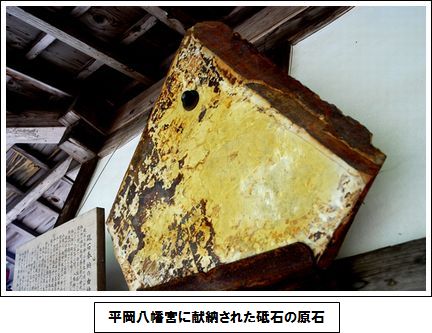
学校から徒歩5分の宝ヶ池の山には、約2億年前の深海底で起こった自然の営みが見事に刻まれています。大繁殖したプランクトンの放散虫が堆積した「層状チャ-ト」とは別に、ある時期にはとても細かな粒子が堆積した時期がありました。この粒子は当時の大陸から風によって舞い上げられたものが、大洋の深海底で堆積したと考えられています。この地層が宝ヶ池の山中にも露出しています。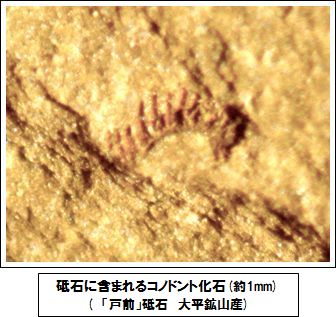 地質学的には「珪質頁岩(砥石型珪質頁岩)」と呼ばれ、よく層状チャ-トに伴って産出します。京都では有名な「鳴滝砥石」や亀岡で現在も採掘されている砥石層と同質の岩石です。古生代二畳紀末~中生代三畳紀にかけての特徴的な地層です。この時期に地球上では一体何が起こったのでしょうか。この地層には「海洋無酸素事変」の産物と言われている炭素濃集層(Black band)が含まれることもあり、海洋の95%の生物がこの時期に絶滅したとも推測されています。
地質学的には「珪質頁岩(砥石型珪質頁岩)」と呼ばれ、よく層状チャ-トに伴って産出します。京都では有名な「鳴滝砥石」や亀岡で現在も採掘されている砥石層と同質の岩石です。古生代二畳紀末~中生代三畳紀にかけての特徴的な地層です。この時期に地球上では一体何が起こったのでしょうか。この地層には「海洋無酸素事変」の産物と言われている炭素濃集層(Black band)が含まれることもあり、海洋の95%の生物がこの時期に絶滅したとも推測されています。
砥石には、写真のようなコノドント化石もよく含まれていますが、この動物は三畳紀末で絶滅しました。このコノドントも形態が時代とともに変化し、重要な示準化石のひとつです。
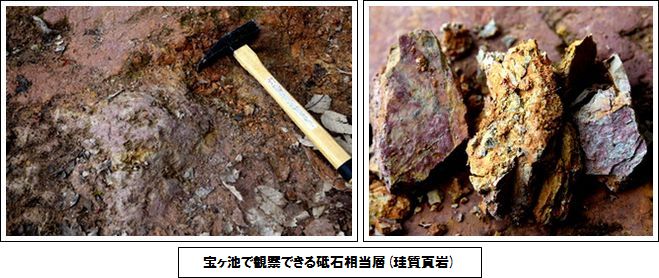
If you walk about 5 minutes from our school to the hills of Takaragaike, you can see what happened about 200 million years ago when nature was at work. As well as the layered chert that formed from the sedimentation of radiolarian, some very fine particles formed some sedimentation at some point in time. Those particles were blown by the wind from the land, and formed sedimentation on the bottom of the ocean. That strata became exposed in the hills of Takaragaike.
In geological terms, this is known as “Siliceous Shale”, and it often produced with layered chert. It is a rock that is the same as the famous Narutaki Grindstone in Kyoto, and the Grindstone that is currently being mined in Kameoka. This is a characteristic of the strata formed between the Permian period and the Triassic period. We wonder what happened on the earth around this time? This strata contains a carbon concentrated layer or “Black Band” which is a product of an anoxic event in the ocean, and it is presumed that 95% of the organisms in the oceans became extinct during this period.
As you can see in the photos, Conodont fossils are often found in the Grindstone (or Sharpening stone), and these animals became extinct in the Triassic period. This Conodont changed its form over the years and became an important index fossil.
《Words》 珪質頁岩 siliceous shale、砥石 Sharpening stone、コノドント Conodont
